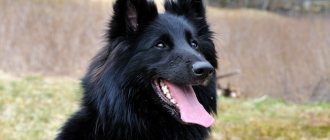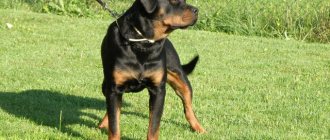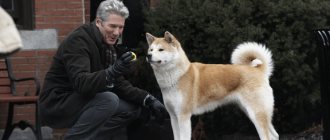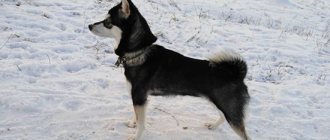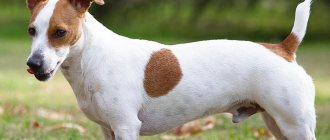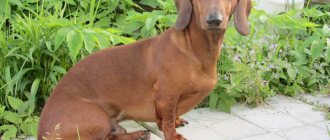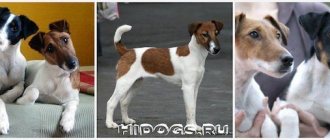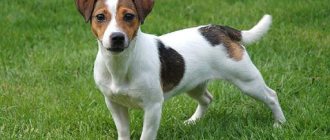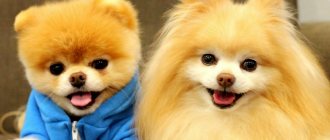/ Dogs / Dog breeds / Characteristics and description of the Belgian Shepherd Groenendael
0
1870
Article rating
The Groenendael is one of the most commonly found varieties of the Belgian Shepherd. The breed was bred in the 19th century to protect homes, people, and also herd sheep. If you decide to buy yourself such an intelligent and loyal friend, then it is worth remembering that the Belgian Groenendael Shepherd is far from being a “couch dog.” The animal needs constant movement, so it will become an excellent companion for energetic and athletic people who are not used to sitting at home in the evening.
Belgian Shepherd Groenendael
History of appearance
Belgian Shepherds were first mentioned back in 1650, when their main task was to help shepherds curb unruly flocks of sheep. But later dog breeders noted their remarkable qualities, such as endurance, hard work and versatility. Then they began to carry out selection in order to strengthen these qualities.
But specifically the Groenendael owes its appearance to the famous dog breeder Nicholas Rose, who lived in the 80s of the 19th century in the town of Groenendael, not far from Brussels. There he had his own estate, Chateau Groenendaal, where two dogs with thick, long hair lived. It was they who gave birth to the first offspring with a characteristic coal-black color, for which many people fell in love with these dogs.
It’s true: they look very mysterious. Since the beginning of the 20th century, Groenendael dogs have taken the path of justice and helped guards, customs officers and police officers carry out their service. They were also often taken to dog competitions. By 1912, the Groenendael was officially recognized by the American Kennel Club. And after that his popularity only grew. Nowadays these dogs are kept more as pets than as competition participants.
Appearance
The Groenendael Sheepdog is one of four lines of the breed, in addition to Laekenois, Malinois and Tervuren. Initially, the lines differed only in color and coat structure. In the modern world, dogs differ in their working characteristics, but the Laekenois breed remains partially recognized to this day. Groenendael is recognized by the whole world; in the USA they are even distinguished as a separate breed. The Belgian's ideal exterior for a shepherd often leads to confusion; Groenendaels are often mistaken for black German Shepherds. However, if you look closely at the photo, the differences between the breeds are obvious.
A coal-black dog with beautiful, shiny and long hair, lively eyes, alert ears, impressive teeth and demonstrative determination - this is Groenendael. Depending on the gender, the body shape of dogs may differ. Bitches are more elongated and flexible, demonstrating an easy, confident gait and flexible character. Males are larger, more athletic, more determined. Believe me, if you find yourself face to face with an unfriendly male Groenendael, you will have a very hard time.
Regardless of the breed line, the Belgian Shepherd is a well-developed, large dog. Depending on gender, height ranges from 56 to 66 cm, weight from 26–30 kg. The dog must demonstrate confidence, poise, alertness and alertness.
The head has a classic shepherd shape with a neatly elongated muzzle and expressive movable eyebrows. The forehead is high, rounded, smoothly turning into the back of the head. The bridge of the nose is smooth, narrowing slightly from the stop line to the pad of the nose. The teeth are large, tightly spaced with well-developed, strong fangs. Scissor bite, without gap. The lips are tightly fitting, the upper lip covers the lower lip, does not droop. Nose is black. The eyes are almond-shaped, set at medium width and height. The look is focused, intelligent, interested. The ears are medium, high and erect, raised.
The body is harmoniously built, the body is strong, the bones are well developed. The neck is proportionately long with a beautiful arch when the dog is standing. The back is wide with pronounced muscles, broad shoulders and a sloping croup. The shoulder blades are inclined forward, which makes movements free, and the withers are almost straight. The chest is as deep as possible (up to the elbow line), moderately wide. The tail is “classic” long and thick. When at rest, the tail is carried low, the tip raised at the level of the hocks. The paws are very strong, proportionally long, with well-developed muscles. The joints are flexible, the hock joints are strong and connected at an angle, parallel to each other. The hips are elongated, the shoulders are wide, smoothly turning into the neck.
Breed dossier
- Country of origin :
Belgium - Classification:
Group 1: Shepherds and Cattle Dogs (excluding Swiss Cattle Dogs)Section 1: Shepherds
- Training :
The dog cannot tolerate rough treatment; patience must be exercised when training. Needs a firm but gentle master's hand. - Color :
Black. There may be small white markings on the chest, on the feet between the pads and on the tips of the toes of the hind feet. - Dimensions .
Height at withers 56-66 cm. Weight 28 kg. - General impression :
Tail: very fluffy, medium length. When the dog is calm, it hangs with the end bent upward; when she is active, it rises. - Usage .
An excellent guard and herding dog. Thanks to its innate protective and guard qualities, the Groenendael is an ideal watchman and protector of the family. He is often used by the police, and he also gets along well with children. At the beginning of the last century, Groenendaels began to be used by the Parisian police, customs officers took these dogs with them when patrolling the borders, the dogs helped shepherds, worked as watchmen and were loyal and reliable working dogs, and successfully performed in working dog competitions. After special training, he can work as a guide for the blind. - Physical activity :
The animal needs long walks. - Character:
- Contents :
Not suitable for indoor use. - Grooming :
The dog's coat must be brushed regularly with a special brush. Bath only if absolutely necessary. - Amenability:
- Diseases :
Obesity, epilepsy, allergies, eye problems, excessive shyness, excessive aggressiveness and even less commonly, hip and elbow dysplasia were sometimes noticed. - Diet :
Do not overfeed this breed as it tends to become obese and lazy. - Lifespan :
About 13-14 years.
Character and temperament
The Groenendael is the most loyal breed , distinguished by incredible speed, strength, endurance and excellent health.
Another character trait is excessive energy , due to the instincts of herding dogs. Therefore, this breed is not suitable for people who are away from home for a long time, leaving the pet inactive. Bored, the pet may start to have fun on its own, which will certainly end in damage to property. By the way, boredom is the main reason why it is not recommended to keep a shepherd in an apartment.
Groenendael has the ideal temperament. This depends on a number of factors such as heredity, training and socialization.
The Shepherd is endlessly friendly , which makes it a wonderful friend for children and other family members. But such friendliness does not extend to the threat that has arisen for the owner or his loved ones, which forces the pet to defend itself without hesitation.
In addition, the Belgian is the “owner” of the territory, which often becomes the cause of conflict with those who have even slightly “encroached” on his property. In order to avoid such conflicts , dog breeders recommend starting training as early as possible.
Care and maintenance
You should only get a Belgian Shepherd if you have enough time to train and care for it. Of course, a lot depends on the type of dog chosen, but in any case, the most labor-intensive part is caring for their coat.
Pets are subject to heavy shedding twice a year, so in summer and winter they need frequent brushing. Do this slowly, using a brush with natural bristles so that there are no torn clumps of hair.
Groenendael is brushed every day during the molting period, otherwise his hair will be everywhere: on clothes, on the bed, on the carpet.
The Laekenois' curly coat is clipped twice a year to maintain a neat appearance. For a short-haired Malinois, brushing once a week is sufficient.
The most difficult thing to care for and maintain is the Belgian Tervuren Shepherd. They have a double undercoat, so they are prone to matting. You should comb it at least twice a week, and also regularly trim the hair between your toes.
Frequent washing of animals of this breed is not recommended. Substances contained in shampoos can damage the hair structure. But regular eye and ear care is necessary. To remove discharge or dirt, use a cotton pad soaked in warm boiled water. The shepherd's nails do not need to be trimmed because they wear down on stones or asphalt during walks.
The oral cavity requires timely care. The teeth are cleaned using a special finger brush, as well as using dog toothpaste, which can be purchased at a veterinary clinic.
Advantages and disadvantages of the breed
Each dog has its own pros and cons, which you should familiarize yourself with before getting a puppy. First the good:
pros
:
- An excellent security guard. Such a dog will always protect and defend its territory.
- Beauty. Nature has awarded the Groenendael with beautiful black wool, which looks impressive and certainly attracts the attention of others.
- Mind. Nature did not deprive him of a high level of intelligence. She immediately understands what’s what in the house and lives by the rules that the owner dictates to her. But it will not allow you to completely dominate yourself.
- Activity. This is a plus for lovers of sports and an active lifestyle. Groenendael will happily run or go hiking with you.
- Good health. However, the dog is susceptible to diseases such as hip or elbow dysplasia, epilepsy, retinal atrophy, hypothyroidism, and cancer.
The rarity of this breed can be attributed to both pros and cons. On the one hand, it is very prestigious to have such a rare breed, but on the other hand, it is not easy to find.
Minuses
:
- A special lifestyle, regular training and mental exercise. Not everyone likes to spend a lot of time with their dog.
- Makings of a leader. May not listen to the owner if he does not consider it necessary.
- Quite a price. Many buyers are scared by the number on the price tag, and they give up the idea of purchasing a puppy. Read more about her.
Caring for Belgian Groenendael Shepherds
Belgian Shepherds of the Groenendael breed are not particularly demanding in care, but you still have to follow some hygiene rules.
Groenendaels have a thick coat with a thick undercoat. Therefore, dogs begin to shed in summer and winter. During this time, you need to comb your pet's fur as often as possible to remove dead hair and improve its appearance. To do this, it is better to purchase a special comb with rare teeth; it will not injure your pet’s skin and fur. Puppies need to be brushed twice a week; for adult dogs, this procedure can be done less frequently. Trimming Groenendaels is prohibited by the standard, as this will worsen the appearance of the animal. It is only permissible to trim the hair between the toes.
Frequent bathing is contraindicated for Groenendaels, since dogs are very sensitive even to special shampoos, which can also seriously damage the coat - it will become dull and thin. And this would already be a violation of standards, since the soft and thin coat of the Groenendael is considered a disadvantage. It is permissible to bathe the dog as needed - only if there is a strong odor. But even in this case, the amount of shampoo should be minimal.
The animal's ears need to be cleaned regularly to prevent diseases from developing. You should wipe your eyes daily with a cotton swab dipped in water.
Since Groenendaels are prone to obesity, they need regular exercise. It is recommended to keep a Groenendael dog in a private house with a large territory, where it can run freely and explore the territory. When kept in an apartment, the pet must be taken for walks regularly.
The Belgian Shepherd's diet should, first of all, be varied; the same foods should not be given every day. The diet must be balanced, since the dog needs fats, proteins and carbohydrates, which will ensure its normal development. It will be useful to give your pet additional vitamins. You can feed at strictly defined hours, and avoid unscheduled snacks. If you decide to feed dry food, first of all, you need to consult with the breeder so that he can help you choose food depending on the dog’s needs.
Appearance of the Belgian Shepherd
General impression
The Belgian Shepherd is a large breed of dog. Her strong build and steely muscles make her look menacing. This is also facilitated by the ferocious grin of sharp teeth. In the photo, the Belgian Shepherd looks menacing, but its temperament is softer than it seems.
Head
The animal's head is folded dry and harmonious. It is somewhat elongated and high-waisted. The flat frontal part is not clearly expressed along the midline. If you look at the profile of a shepherd dog, two parallel lines of the muzzle and forehead are clearly visible. The cheekbones have well-developed muscles, but are not very defined. The brow ridges protrude slightly from the forehead line.
The rather long muzzle of the individual has a narrowing at the end. The nose is black with wide open nostrils. The oral mucosa is also dark in color without pink areas. The lips are thin, pressed tightly to the jaw.
The triangular-shaped ears are pointed at the tips, and, on the contrary, are smoothly rounded at the base. When alert, the ears are positioned straight and vertical.
The shepherd's teeth are strong and white. The bite of the strong jaws is scissor-shaped.
Neck
The fairly long and straight neck has a high set, without a characteristic dewlap, with a smooth, slightly curved scruff. It is slightly widened towards the shoulder blades.
Torso
The dog's body is massive, but does not look heavy due to its almost ideal proportions. In males, the length of the body is equal to the height, while in females the length is slightly longer. The voluminous chest is quite wide, the ribs have a smooth curve. The clearly visible withers merge into a straight topline. The pet's croup is suspended with a slight slope, the abdominal line is well tucked. Rendered muscles are visible throughout the body.
Forelegs
The front legs have strong bones and muscles. A wide angle is formed when the elongated shoulder blades meet the shoulders. Short pasterns with rounded paws turn into tightly clenched fingers with strong, dark-colored claws.
Hind limbs
The hind legs stand perpendicular to the ground and are characterized by strong muscles on the broad thighs and lower legs. The hock joints are fairly arched. The oval-shaped paws have durable pads.
Tail
The tail is of medium length and appears wide at the base. At rest it is lowered, and when in motion it is raised, without forming a curl or curvature.
Movement
The shepherd is very active. While running, due to her temperament, she cannot move in a straight direction for long; she needs a lot of space. More often the dog uses a trot or a relatively calm walk, but sometimes it moves at a gallop. Her movements are sharp and springy.
Wool
The pet's coat is quite dense with a thick undercoat. But each of the four varieties of shepherd dog has its own distinct characteristics:
- Groenendael has a long, smooth coat without a glossy sheen;
- Laekenois has coarse, rough-to-the-touch, tousled hair;
- Malinois is a representative of the shepherd dog with short hair;
- The Tervuren is similar in type to the Groenendael, but the face has characteristic eyebrows, a beard and mustache.
Regardless of coat length, Belgian dogs require careful grooming.
Color
The colors of the Belgian Shepherd differ from each other along each line. So, Groenendaels are black dogs with white spots on the toes or chest. The Laekenois is a reddish hue with white markings and a darker muzzle and tail. The Malinois is an interesting tan color with black ears and muzzle. The Tervuren's coat is similar in color to the Malinois, but the chest and fingers are colored white.
Size
The Belgian Shepherd is quite large in size, but it looks neat and very proportional. The height of females at the withers reaches 56-61 cm, and males - up to 61-66 cm. The weight of the Belgian Shepherd ranges from 20 to 30 kg, depending on gender.
Education and training
The process of socialization and education of the Groenendael should begin as early as possible. Familiarize the dog with its place, teach it to walk on a leash and respond to its name. Training also begins at an early age.
The load level should be determined depending on the age of the animal:
- Puppies up to 4 months old are trained for 20 minutes a day.
- Dogs up to 6 months old are able to train for 30 minutes, 2 times a day.
- After six months, the duration of training should be 40 minutes in the morning and evening.
To motivate your pet, give him a treat after a successful exercise.
Important! Groenendael has high mental abilities, he quickly learns all commands.
How to choose a Belgian Shepherd puppy
Groenendael puppies require the most attention of all Belgian Shepherds. At an early age they are overly active and require constant physical and intellectual stress. Before buying a puppy, you need to soberly assess the condition and size of the home, check for allergies in family members, and make sure you have enough time and finances for the pet. You should not buy an animal from a photo or video: there is a high risk of getting not a purebred Groenendael, but an ordinary mongrel. You can only buy a puppy from a professional breeder or nursery.
Rules for choosing and preparing for the arrival of a new family member:
- Talk to your puppy before you adopt him into your family. The animal also has the right to choose, and the Groenendael may not like you for a number of reasons.
- Make your home safe for your puppy in advance. There should be no plants, personal belongings, or electrical appliances in the public domain.
- Form a training strategy and distribute the care of the animal among family members.
- Choose only a well-groomed, active puppy, with clean skin and mucous membranes. Check your baby for hernias (bulges in the navel area).
- Play with the puppy. If he ingratiates himself in every possible way, tries to pay attention, behaves friendly and affectionately, you can safely take your pet home. Experienced dog breeders say that it is necessary to feel a connection with the dog, to feel love and affection for it.
The price of Belgian Shepherd puppies starts from $500. If you want to save money, you can consider purchasing a dog from a private breeder. In this case, the price will be slightly lower - about $350. However, we must not forget to carefully check the pedigree and veterinary passport of the animal, which should contain information about vaccinations.
Nutrition
Groenendaels are unpretentious in nutrition. Be sure to include in their diet all possible sources of vitamins and microelements:
- vegetables;
- fruits;
- greenery;
- meat;
- sea fish;
- dairy products;
- eggs;
- porridge;
- clean water.
If necessary, add vitamins separately to your pets' food.
You should not give them spicy, salty, smoked foods and sweets, as well as food to which the dog may have a food allergy.
It is not advisable to give dry food to shepherds, but it is possible. Try mixing it with natural food to make it easier to digest.
Owner reviews
The Belgian Shepherd, by its nature, really needs a lot of space for physical activity. When kept in apartment conditions, it is necessary to provide such a pet with long walks, as well as additional exercises.
This is interesting!
Belgian Shepherds are characterized as strong and very hardy dogs with fairly strong immunity and excellent adaptability to different weather conditions.
“Belgians” of any variety captivate with their grace, innate intelligence and extraordinary mind. Such a pet will become an excellent companion and faithful guard. Despite the apparent “sameness” of character, each variety of Belgian Shepherd has individual, unique traits:
- The Groenendael is a sensitive, unpretentious, inquisitive variety that is perfect for any type of “dog work”, from competitions to various rescue activities;
- Tervuren will become an excellent watchman, never attacking for no apparent reason, but clearly knowing all his duties;
- The Malinois is one of the dogs with pronounced guarding and protective qualities, and is also the most mentally strong, dominant of all the “Belgians”;
- Laekenois is considered the most good-natured, obedient and calm of all varieties, therefore it is most often purchased by families with children and people of retirement age.
According to experienced dog breeders and professional dog handlers, before starting to train and train a “Belgian”, a trusting relationship must develop between the owner and the pet, which will allow the dog to feel and get used to authority.
At the slightest weakness, the Belgian Shepherd often shows a willfulness of character, so the issue of training must be approached very competently.
